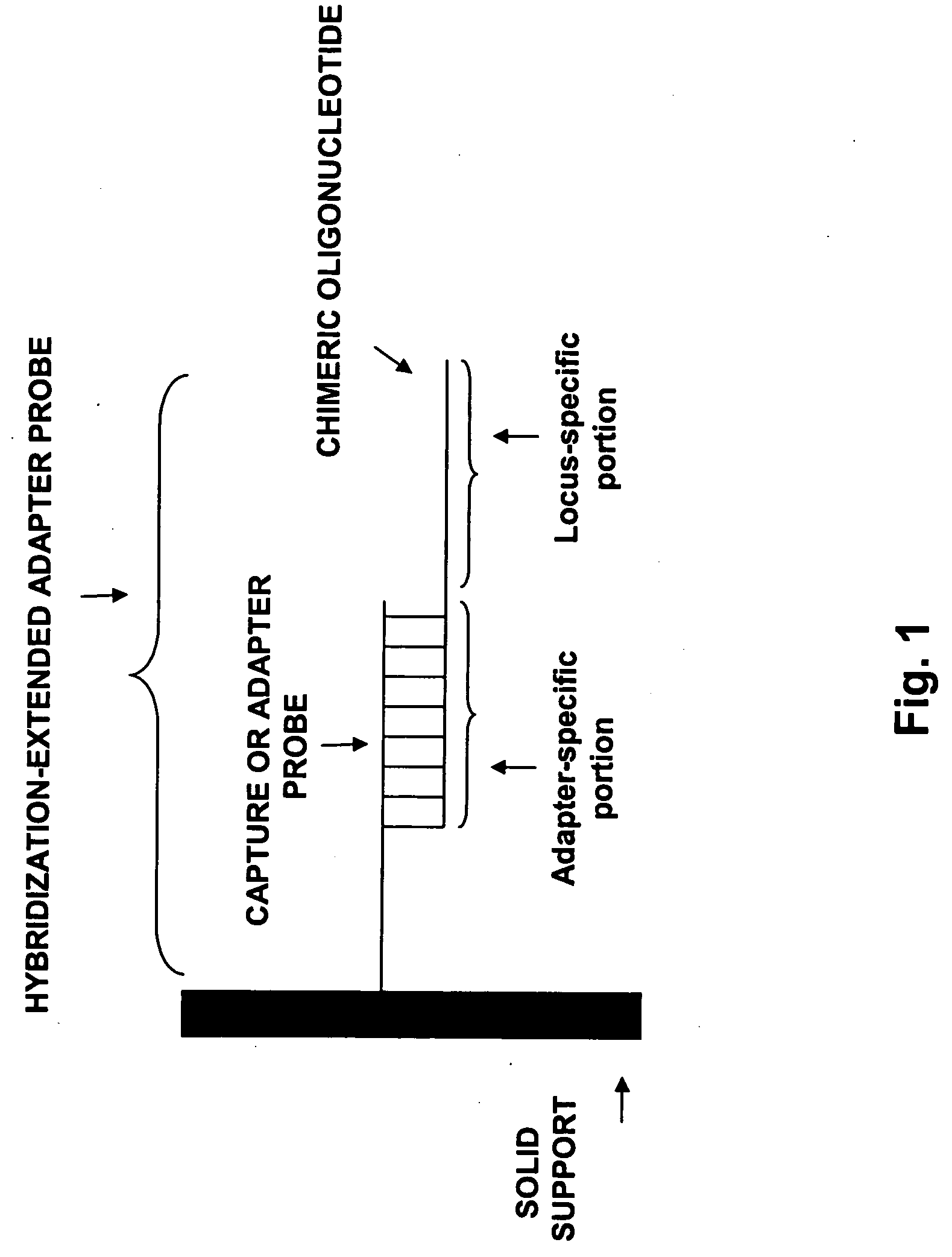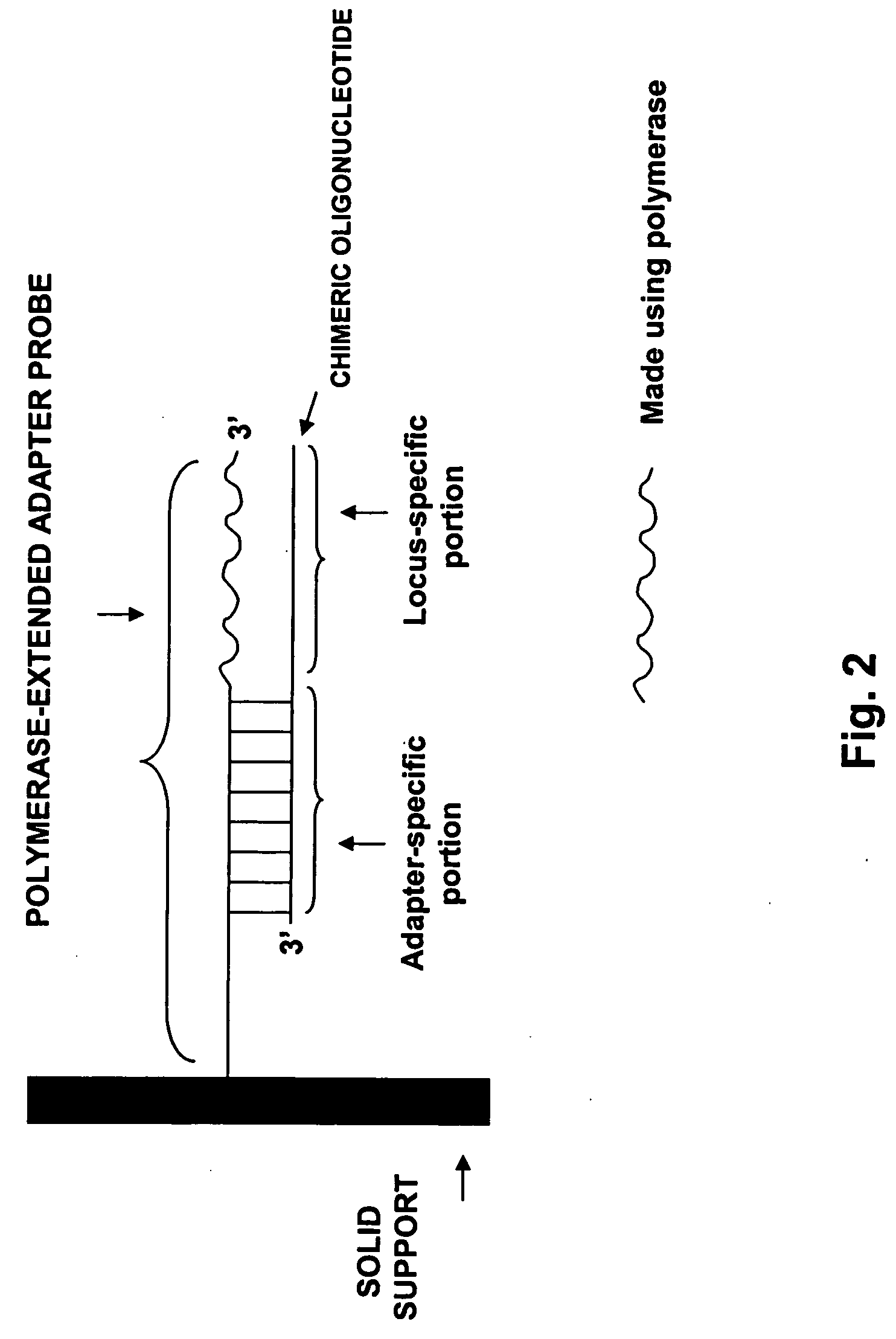Methods and compositions for making locus-specific arrays
a technology of locus-specific arrays and arrays, applied in the field of locus-specific arrays, can solve the problems of expensive and time-consuming creation of arrays of many different locus-specific capture probes
- Summary
- Abstract
- Description
- Claims
- Application Information
AI Technical Summary
Problems solved by technology
Method used
Image
Examples
example 1
“Sandwich” Hybridization Extension of Adapter Probe
[0184] Adapter-probes on a universal array are converted into locus-specific oligonucleotides by hybridization to chimeric oligonucleotides that contain both an adapter-specific sequence and a locus-specific sequence. The resulting hybrid is tested by evaluating the ability of the extended adapter probe to detect labeled target oligonucleotides.
[0185] Chimeric oligonucleotides containing an adapter-specific portion and a locus-specific portion are hybridized to a universal array having DNA adapter probe attached at assay locations. The chimeric oligonucleotide is synthesized with a psoralen moiety at its 5′ end. Psoralen can also be incorporated internally or at the 3′ end of an oligonucleotide by modifying an amine-labeled oligo with psoralen-NHS (Pierce). Typically, the psoralen is placed adjacent to an AT dinucleotide on the adapter-specific sequence. Chimeric oligonucleotides are hybridized at high stringency (40% formamide, r...
example ii
Polymerase Extension of Adapter Probe
[0189] A universal DNA array was converted into a locus-specific array by polymerase extension of the adapter probe. The efficiency of polymerase extension was tested by evaluating the ability of the extended adapter probe to detect labeled target oligonucleotides.
[0190] A pool of ninety-six 76-mer chimeric oligonucleotides, each containing a different adapter-specific portion and a different locus-specific portion, was hybridized to a universal array. The universal array contained bead types having the adapter probe oligonucleotides represented in the chimeric oligonucleotide pool. The orientation of probes on the universal array was such that these probes could be used as primers in a polymerase extension reaction given a suitably hybridized chimeric oligonucleotide.
[0191] Chimeric oligonucleotides were also gel-purified and tested in the extension assay, to examine the effect of removing truncated oligonucleotides from the annealing mix. Th...
example iii
Extension of Adapter Probe Using Enzyme Ligation
[0202] Adapter probe oligonucleotides of a universal array are converted into locus-specific oligonucleotides by hybridizing a third oligonucleotide to a hybridization complex generated as in Example I. The third oligonucleotide sequence is complementary to a locus-specific sequence of the chimeric oligonucleotide. Hybridization is carried out under stringent conditions, and the resulting hybrid is washed.
[0203] The 5′ end of the third oligonucleotide is ligated to the 3′ end of the adapter probe oligonucleotide using T4 DNA ligase. The T4 DNA ligation buffer consists of the following: 50 mM Tris-HCl (pH 7.8), 10 mM MgCl2, 10 mM DTT, 1 mM ATP, 50 μg / ml BSA, 100 mM NaCl, 0.1% TX-100 and 2.0 U / μl T4 DNA ligase (New England Biolabs). Reactions are performed at 30° C. The ligation reactions are incubated from 2 to 16 hours.
[0204] Following ligation, arrays are washed 5-10 times with 1×SSPE (pH 7.4, 22° C.) on a GeneChip fluidics station...
PUM
| Property | Measurement | Unit |
|---|---|---|
| Length | aaaaa | aaaaa |
| Composition | aaaaa | aaaaa |
Abstract
Description
Claims
Application Information
 Login to View More
Login to View More - R&D
- Intellectual Property
- Life Sciences
- Materials
- Tech Scout
- Unparalleled Data Quality
- Higher Quality Content
- 60% Fewer Hallucinations
Browse by: Latest US Patents, China's latest patents, Technical Efficacy Thesaurus, Application Domain, Technology Topic, Popular Technical Reports.
© 2025 PatSnap. All rights reserved.Legal|Privacy policy|Modern Slavery Act Transparency Statement|Sitemap|About US| Contact US: help@patsnap.com



